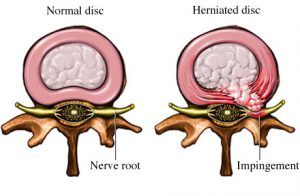Stop the cycle for lower back pain
by Doctor of Physical Therapy Troy Vander Molen
As you are well aware, lower back pain is a common occurrence. Lower back pain is second only to the common cold as a reason for missed work time. So if you’re an adult, you’re more likely to experience an episode of lower back pain than not.
 One common explanation for lower back pain is disc bulging (small) or disc herniation (larger). About 90% of bulging discs occur in the lower back (or lumbar) area of the spine. The presence of a disc bulge is very common. In fact, disc bulges could be considered normal. Therefore, if you’ve been told that you have a disc bulge – or even a more significant disc herniation – don’t fret.
One common explanation for lower back pain is disc bulging (small) or disc herniation (larger). About 90% of bulging discs occur in the lower back (or lumbar) area of the spine. The presence of a disc bulge is very common. In fact, disc bulges could be considered normal. Therefore, if you’ve been told that you have a disc bulge – or even a more significant disc herniation – don’t fret.
In a study published in the New England Journal of Medicine over a decade ago, 98 people without pain were given an MRI examination. Only 35 of them had what doctors consider “normal discs at all levels.” The majority of the people without pain (52%) had disc bulges at one or multiple levels, and 27% had at least one disc herniation. In fact, the conclusion of the study said this: “The discovery by MRI of protrusions (disc herniation) in people with low back pain may frequently be coincidental.”
The Cleveland Clinic performed a follow-up study and concluded that “as many as 60% of healthy adults with no back pain have degenerative changes in their spines.” In other words, disc bulging or herniations may contribute to lower back pain, but they also may not contribute to low back pain.
What’s interesting is that in many cases the findings of disc changes are diagnosed using expensive medical imaging like an MRI. And people who undergo an MRI are more likely to have lower back surgery. Unfortunately, lower back surgery is often not effective at eliminating lower back pain. The MRI can be a false alarm of sorts that reinforces the idea that something is broken, and nothing is worse for lower back pain than fear.
The way that a human processes neurological input is extremely complex. If you like TED talks and love to hear an Australian accent, click on this link (https://www.youtube.com/watch?v=gwd-wLdIHjs#t=8s) to hear Lorimer Moseley, a clinical scientist and pain expert, talk about “Why Things Hurt.”
If you’re more interested in a simplified example, consider this explanation I recently heard about how information is processed differently based upon how the brain frames the input.
Imagine that you are traveling and have a reservation to sleep in an extremely beautiful but old home down a long, gravel driveway in the middle of nowhere. You have heard stories about this old home. Stories that tell of a horrific incident that occurred once upon a time, and now some believe that the place is haunted.
On the night you’re there, the weather turns bad. There is thunder, lightning, wind, and heavy rains. The house is making all kinds of noises, and you are all alone. How do you expect you’d sleep that night?
Imagine instead that you had not heard any bad stories about this house. In fact, you heard stories that told of the former residents from 100 years prior who were wonderful human beings and philanthropists.
The weather that night is beautiful and calm with a full moon. You turn in with the windows slightly open, and you can feel a cool, gentle breeze. There are noises, but the house is old. That’s to be expected. How do you expect you’d sleep that night?
 The brain is extremely powerful, and the way we think about our physical condition matters. That is the problem with MRIs and other diagnostic tests. It shows you a problem that your brain may discern as a threat, particularly if you’ve heard stories from others about their lower back problem. If you have a friend or family member that dealt with an extreme lower back problem and found out that you have some of the exact same findings on the MRI as him or her, what will your brain think about your condition? Will it be helpful to your recovery or not?
The brain is extremely powerful, and the way we think about our physical condition matters. That is the problem with MRIs and other diagnostic tests. It shows you a problem that your brain may discern as a threat, particularly if you’ve heard stories from others about their lower back problem. If you have a friend or family member that dealt with an extreme lower back problem and found out that you have some of the exact same findings on the MRI as him or her, what will your brain think about your condition? Will it be helpful to your recovery or not?
So, here’s the reality. Almost every lower back pain issue is temporary. In addition to lower back pain, if you have symptoms of pain shooting down your leg, most of these symptoms will resolve within a few weeks. Don’t fret. These things happen.
Almost everyone has less than ideal findings in the spine. These too are normal and expected. In most cases, there is not a direct correlation between these findings and your back problem.
There are only a few situations that make an MRI or other diagnostic testing a wise decision. If you’d like to know if you may have the need for this type of intervention, consider contacting our clinic to speak to one of our lower back specialists. We would love to meet briefly with you for a free consultation to ease your fears and help you find the real problem and the real solution for your lower back condition. Call us today (866-588-0230) or email us to reserve a slot on our schedule. You can also sign up for our upcoming workshop in Ames where you can learn more about your unique solution to lower back pain.



